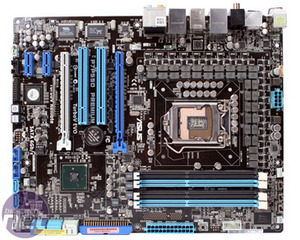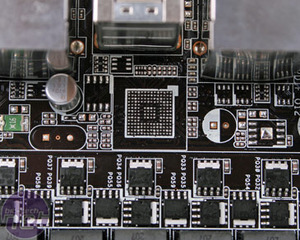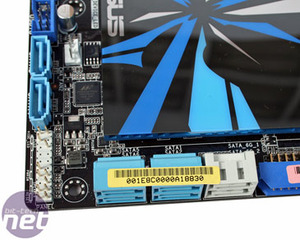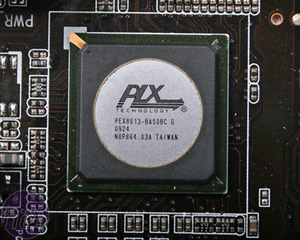Investigating SATA 6Gbps Performance
November 16, 2009 | 10:00

Asus P7P55D Premium
Asus' P7P55 Premium is the UD6 equivalent above with all the bells and whistles on it, bar Republic of Gamers hardware. It features the same razor sharp black and blue design of its other P55 boards, and we certainly feel the layout is somewhat better than Gigabyte's UD6 board: there's no conflict with a northbridge heatsink for starters.On our board though, Asus has eschewed the USB 3.0 NEC chip, opting to just fill it with standard USB 2.0 ports instead, and we still have the same eight of SATA ports as the Gigabyte board featured on the previous page.


The Asus board, sans heatsinks, and a closeup of the solder points for the NEC USB 3.0 chip but does not include it
There's the TurboV remote, that some in the office affectionately refer to as "the stair-lift remote", even though it's actually quite useful. In addition to the "Xtreme Design" that features ExpressGate everyone disables as well as the MemOK button, EPU, TProbe and more CPU power circuitry e-peen than you can shake a truck load of MOSFETs at, because Asus somehow manages to turn a "32+3" phase circuit into "48" phases - a new calculator is in the post.
Instead of relying on Intel's excuse for a modern southbridge, Asus bolts the Marvell 88SE9123 SATA 6Gbps to a PLX chip that permanently converts two PCI-Express x1 Gen 1 lanes into one PCI-Express x1 Gen 2 lane. With the 88SE9123, Asus negates the offering of RAID from both ports, unlike Gigabyte.

This simultaneously reduces the number of possible PCI-Express lanes from the P55 PCH for extra hardware and costs more because of the extra PLX chip, but it doesn't rely on any auto-detection, BIOS settings or compromising graphics bandwidth like the Gigabyte P55A does. It also means Asus doesn't have to fork out for another chip to provide the IDE, like Gigabyte does.

MSI MPG Velox 100R Chassis Review
October 14 2021 | 15:04











Want to comment? Please log in.